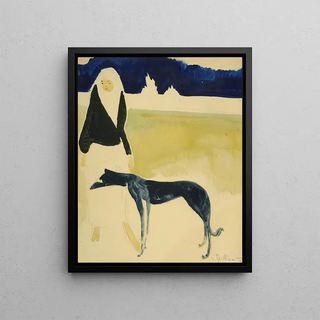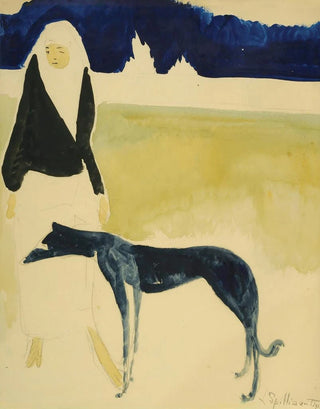Art print | Woman with Greyhound - Léon Spilliaert


View from behind

Frame (optional)
Femme au lévrier - Léon Spilliaert – Captivating introduction
In the fascinating universe of art, some works manage to transcend the simple frame of the canvas to evoke deep emotions and intimate reflections. "Femme au lévrier" by Léon Spilliaert is one of those creations that capture the very essence of solitude and beauty. This artwork, created in the early 20th century, immerses us in a world where melancholy and grace intertwine. Through the gaze of this woman, who appears both dreamy and distant, the artist invites us to explore universal themes such as introspection, the relationship with others, and the quest for self. The presence of the greyhound, a symbol of loyalty and refinement, enhances this atmosphere of mystery and delicacy.
Style and uniqueness of the work
Léon Spilliaert's style is distinguished by his bold use of colors and shapes. In "Femme au lévrier," the palette is dominated by dark, almost monochrome shades, creating a striking contrast with the brightness of the female figure. This duality between shadow and light gives the artwork a rare emotional depth. The composition, both simple and complex, highlights the slender silhouette of the woman, who stands out against an enigmatic background. The fluid lines and delicate contours demonstrate impressive technical mastery, while subtle details, such as the facial expression and the posture of the greyhound, reveal a keen sensitivity to the psychology of the characters. This unique approach makes "Femme au lévrier" an essential work, continuing to inspire and delight art enthusiasts.
The artist and his influence
Léon Spilliaert, an emblematic figure of Belgian symbolism, managed to forge a singular artistic identity. His career, marked by a constant exploration of themes of isolation and contemplation, has influenced many contemporary and later artists. Spilliaert draws inspiration from his own experiences, notably his relationship with the sea and the city of Ostend, which is reflected in his works. His ability to capture the essence of the human soul through representations

Matte finish

View from behind

Frame (optional)
Femme au lévrier - Léon Spilliaert – Captivating introduction
In the fascinating universe of art, some works manage to transcend the simple frame of the canvas to evoke deep emotions and intimate reflections. "Femme au lévrier" by Léon Spilliaert is one of those creations that capture the very essence of solitude and beauty. This artwork, created in the early 20th century, immerses us in a world where melancholy and grace intertwine. Through the gaze of this woman, who appears both dreamy and distant, the artist invites us to explore universal themes such as introspection, the relationship with others, and the quest for self. The presence of the greyhound, a symbol of loyalty and refinement, enhances this atmosphere of mystery and delicacy.
Style and uniqueness of the work
Léon Spilliaert's style is distinguished by his bold use of colors and shapes. In "Femme au lévrier," the palette is dominated by dark, almost monochrome shades, creating a striking contrast with the brightness of the female figure. This duality between shadow and light gives the artwork a rare emotional depth. The composition, both simple and complex, highlights the slender silhouette of the woman, who stands out against an enigmatic background. The fluid lines and delicate contours demonstrate impressive technical mastery, while subtle details, such as the facial expression and the posture of the greyhound, reveal a keen sensitivity to the psychology of the characters. This unique approach makes "Femme au lévrier" an essential work, continuing to inspire and delight art enthusiasts.
The artist and his influence
Léon Spilliaert, an emblematic figure of Belgian symbolism, managed to forge a singular artistic identity. His career, marked by a constant exploration of themes of isolation and contemplation, has influenced many contemporary and later artists. Spilliaert draws inspiration from his own experiences, notably his relationship with the sea and the city of Ostend, which is reflected in his works. His ability to capture the essence of the human soul through representations






